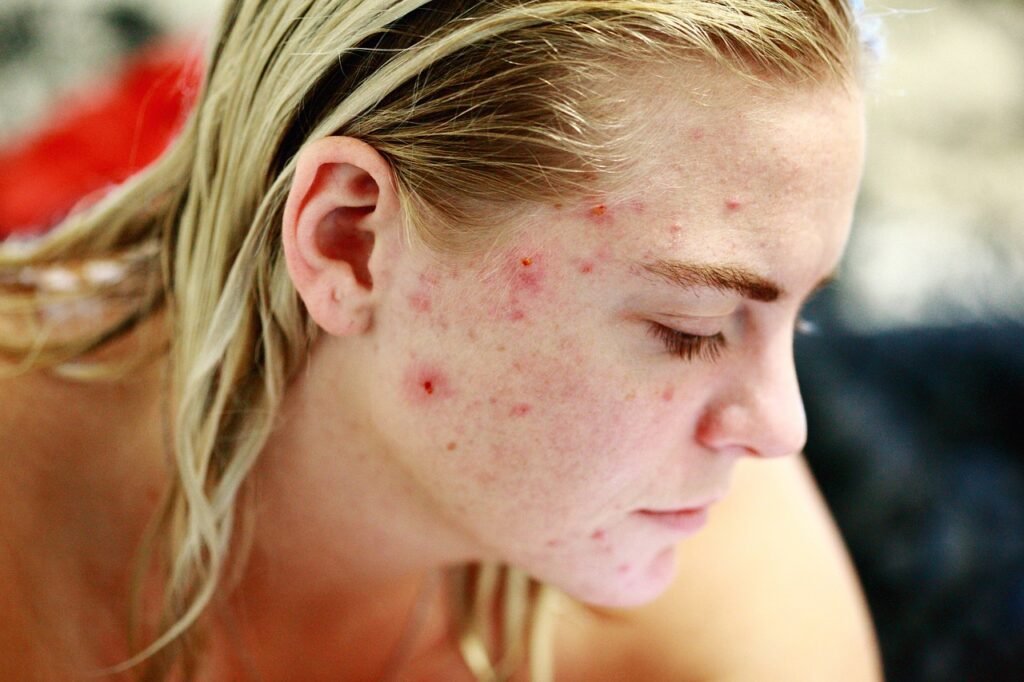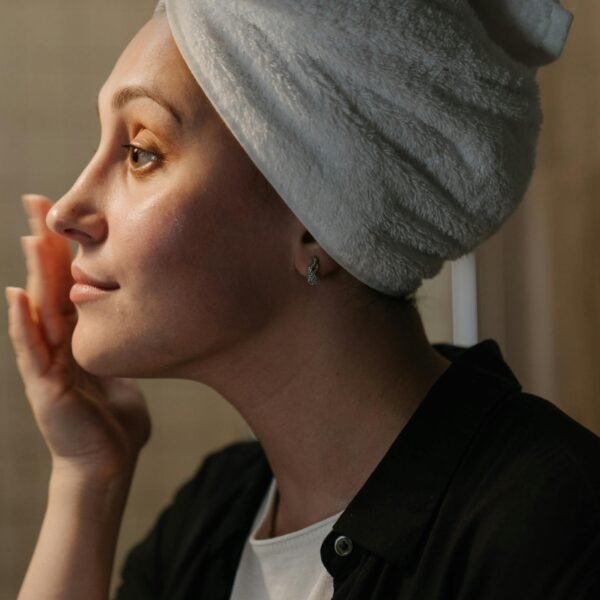Today, we will look into a topic that many of us might not be familiar with but could be the secret to clearer, healthier skin: Acne Mechanica treatment. This guide is designed for anyone who’s been battling those stubborn, friction-induced breakouts and feels like they’ve tried everything with little success.
Acne Mechanica can be particularly frustrating because it’s often caused by everyday activities and habits. Whether you’re an athlete, wear tight clothing, or just find yourself sweating more than usual, these can all contribute to those pesky bumps. But don’t worry, I’ve got you covered!
I’m going to share everything I’ve learned about treating and preventing Acne Mechanica. I’ve been there – dealing with the irritation and the relentless search for solutions. By the end of this post, you’ll have a clear, step-by-step plan to tackle this type of acne head-on and start seeing real results.
What is Acne Mechanica
Acne Mechanica is a type of acne that’s triggered by friction, pressure, heat, and occlusion against your skin.
Unlike regular acne vulgaris which is caused by the clogging of the hair follicle with excess sebum and dead skin cells, which provides a favorable environment for the bacteria Propionibacterium acnes (P. acnes) to thrive, leading to inflammation and the formation of pimples.
Unlike other types of acne, which can be influenced by hormones or genetics, Acne Mechanica is more about your daily habits and the external factors affecting your skin.
Cause of Acne Mechanica
Acne Mechanica can happen from things like tight clothing, sports equipment, or even just resting your face on your hands too often. Essentially, anything that rubs, presses, or traps excess heat against your skin can lead to these annoying breakouts.
Risk Factors
You might be wondering if you fall into the category of people who are more likely to develop Acne Mechanica. Simply put, anyone exposed to frequent rubbing or friction on their skin is at risk.
If you’re an athlete, frequently wear tight-fitting clothes, or use equipment that comes into constant contact with your skin, you’re more susceptible. Think of the football player with a helmet on for hours or the dancer wearing tight leotards and costumes – both are prime examples.
Like during the pandemic, when there was frequent use of face masks. So anyone who uses a facemask for long periods of time is at risk.
What are the symptoms?
The symptoms of Acne Mechanica can vary, but they typically include small, red bumps that can sometimes turn into pustules or cysts if not treated properly.
You’ll often notice these breakouts in areas where there’s the most friction – like your forehead (thanks to hats or helmets), shoulders, back, or even your chin and jawline if you’re constantly touching your face.

Prevention Strategies
Prevention is always better than cure, right? Especially when it comes to Acne Mechanica, there are several proactive steps you can take to keep those breakouts at bay.
- Reducing Friction and Pressure
First and foremost, reducing friction and pressure on your skin is key. Here are some simple tips:
- Wear loose-fitting clothing: Opt for fabrics like cotton that allow your skin to breathe. Tight, synthetic materials can trap sweat and increase friction, leading to breakouts.
- Use protective gear correctly: If you’re an athlete or need to wear equipment, make sure it fits well and isn’t too tight. Consider using moisture-wicking pads or liners to reduce friction and absorb sweat.
- Clean your gear and clothing regularly: Sweat and bacteria build up on your clothes and equipment, which can transfer to your skin. Wash your sports gear, helmets, and clothing frequently to keep them clean and fresh.
- Moisture-wicking fabrics: Invest in athletic wear made from moisture-wicking materials. These fabrics help draw sweat away from your skin, reducing the risk of irritation and acne.
- Personal Hygiene Recommendations
Good hygiene is another crucial aspect of preventing Acne Mechanica. Here’s what you should do:
- Shower immediately after sweating: Don’t let sweat sit on your skin for too long. Shower as soon as possible after workouts or any activity that causes you to sweat. Use a gentle cleanser to remove sweat, dirt, and bacteria.
- Skincare Routine Consistency
Consistency is crucial for effective acne management. Stick to your skincare routine and monitor how your skin responds to treatments:
- Gentle cleansing routines: Avoid harsh scrubs and exfoliants that can irritate your skin. Instead, use mild, non-comedogenic cleansers that won’t clog your pores.
- Patience: Allow time for treatments to work and avoid switching products frequently, as this can irritate your skin further.
- Consultation: If over-the-counter treatments aren’t effective, consider consulting a dermatologist for personalized advice and prescription options.
Over-the-Counter Treatments for Acne Mechanica
When dealing with Acne Mechanica, effective treatment often starts with accessible over-the-counter options. These treatments can help manage symptoms and reduce breakouts effectively. Here are several key treatment options to consider integrating into your skincare routine:
1. Beta-Hydroxy acids: Salicylic acid is a beta-hydroxy acid that penetrates deep into pores to dissolve excess oil and dead skin cells, preventing clogged pores that lead to acne. It also has anti-inflammatory properties to reduce redness and swelling.
2. Benzoyl Peroxide: Benzoyl peroxide is known for its ability to kill acne-causing bacteria and decrease inflammation. Start with a lower concentration (2.5% to 5%) to minimize irritation.
3. Sulfur: Sulfur is a gentle yet effective ingredient that helps absorb excess oil and promote the healing of acne lesions. Sulfur has natural antimicrobial properties that help reduce acne-causing bacteria. It also helps unclog pores and reduce inflammation, making it suitable for sensitive skin types.
4. Alpha Hydroxy Acids (AHAs): AHAs, such as glycolic acid and lactic acid, are exfoliating agents that help remove dead skin cells and promote cell turnover:
5. Retinoids: Over-the-counter retinoids, like adapalene, promote cell turnover and prevent pore blockage. They reduce acne lesions, improve skin texture, and help prevent future breakouts. Retinoids are beneficial for mild to moderate acne cases.
6. Azelaic acid: A gentle exfoliating acid that can be used daily with anti-inflammatory and antibacterial properties.
When to See a Dermatologist
If over-the-counter treatments haven’t effectively managed your Acne Mechanica or if you experience:
- Persistent breakouts despite skincare efforts
- Severe inflammation, cysts, or nodules
- Acne that leaves scars or hyperpigmentation
- Acne impacting your self-esteem or quality of life
Seeking dermatological advice ensures a comprehensive evaluation and personalized treatment plan.
Prescription Treatments
When dealing with persistent or severe Acne Mechanica, consulting a dermatologist can provide access to effective prescription treatments tailored to your specific needs. Here’s what to consider:
Common Prescription Treatments
Dermatologists prescribe a range of treatments depending on the severity and type of acne. Common options include:
- Topical Antibiotics: Topical antibiotics, such as clindamycin and erythromycin, are effective for reducing acne-causing bacteria and inflammation.
- Oral Antibiotics: For moderate to severe Acne Mechanica, oral antibiotics like doxycycline or minocycline are prescribed to reduce inflammation throughout the body and control bacteria.
- Prescription Retinoids: Topical retinoids, such as tretinoin (Retin-A) and adapalene (Differin), are derivatives of vitamin A that promote skin cell turnover, prevent pore blockage, and reduce inflammation.
Other Dermatologist-Recommended Acne Mechanica Treatments.
Depending on your specific condition and response to treatments, dermatologists may recommend:
- Isotretinoin (Accutane): A potent oral retinoid reserved for severe, treatment-resistant acne.
- Corticosteroid Injections: For rapidly reducing inflammation in cystic acne lesions.
- Advanced Dermatological Procedures: Such as chemical peels, laser therapy, or microdermabrasion to improve skin texture and reduce acne scars.
Home Remedies and Natural Treatments
In addition to medical and over-the-counter treatments, incorporating home remedies and natural treatments can complement your acne management routine. These gentle and natural approaches can help soothe inflammation, reduce acne severity, and support overall skin health:
1. Gentle Cleansing with Natural Products
Natural products such as tea tree oil and aloe vera offer gentle cleansing and antimicrobial properties:
- Tea Tree Oil: Known for its antibacterial and anti-inflammatory properties, tea tree oil can help reduce acne-causing bacteria on the skin. Dilute tea tree oil with a carrier oil before applying directly to affected areas to avoid skin irritation.
- Aloe Vera: Aloe vera gel has soothing and anti-inflammatory effects, making it ideal for calming irritated skin.
2. Using Non-Comedogenic Moisturizers
Moisturizing is crucial even for acne-prone skin. Opt for non-comedogenic moisturizers that won’t clog pores:
- Choosing the Right Moisturizer: Look for labels that indicate “non-comedogenic” or “oil-free.” These moisturizers help hydrate the skin without exacerbating acne.
- Application: Apply a pea-sized amount evenly to clean skin morning and night, focusing on areas prone to dryness without over-applying.
3. DIY Masks and Treatments
DIY masks and treatments using natural ingredients can provide additional benefits for acne-prone skin:
- Clay Masks: Clay masks, such as kaolin or bentonite clay, can help absorb excess oil and impurities from the skin.
- Honey Masks: Raw honey has antibacterial properties that can help reduce acne-causing bacteria and soothe inflammation.
- Oatmeal Masks: Oatmeal is soothing and can help calm irritated skin.
Conclusion
In conclusion, managing Acne Mechanica requires a multifaceted approach that combines proper skincare, lifestyle adjustments, and, if necessary, medical treatments.
By understanding the causes and implementing targeted solutions, you can effectively reduce acne breakouts and promote clearer, healthier skin.
Consistency in your skincare routine, including gentle cleansing and appropriate moisturization, is essential for long-term maintenance.
Additionally, consulting with a dermatologist can provide personalized guidance and treatments tailored to your specific skin needs.
Remember, achieving clear skin takes time and patience, but with the right strategies, you can achieve and maintain optimal skin health.





Leave a Reply